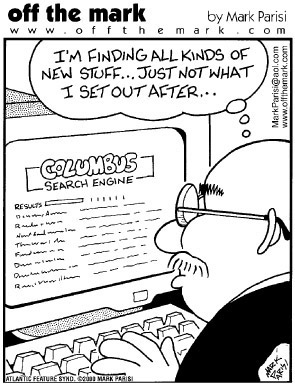Chapter 5: Search Bloopers
| < Day Day Up > |
Overview
In the introduction to this book, I summarized the early days of the Web. Now let's examine the history of Web search.
In 1991, before Mosaic sparked the Web's rapid growth, the world's websites could be counted on two hands. There was no need for anything like our present-day search websites and comprehensive Web directories: AltaVista, Excite, Google, Yahoo. The particle physicists who were the primary users of the early Web knew all the sites. To visit a site, they just typed its URL into a browser. However, this only means that there was no need to search for websites on the early Web. It doesn't mean that there was no need for search.
The early physics websites had relatively few fixed HTML pages: usually less than a dozen . However, the main purpose of those sites was to provide access to databases ”of physicists, physics data, and research paper citations. Those databases were large. Out of necessity, they provided search capabilities. When a user clicked on a Search link (Figure 5.1), a special search window [1] appeared, providing a box into which search terms could be typed. Search results were displayed as a list of links to the actual items, [2] just as they are today. Thus, searching was a part of the Web from the beginning.

Figure 5.1: slacvm.slac. stanford .edu (Dec. 1991) ” A ” High-energy physics (HEP) preprint database page from first U.S. website. B ” Search dialog box for HEP database (reached by clicking the Search link in the page on the left). (To see these pages and more of the first U.S. website, visit www.slac.stanford.edu .)
As the Web expanded in the late 1990s, it essentially became a gigantic database. One doesn't usually find information in a database by browsing or "surfing." One searches.
As more websites came online, the average number of pages per site also increased. Some sites today have more pages than the entire Web had in 1991. Furthermore, many of today's websites provide access to large databases of products, legislation, court decisions, weather, movies, history, sports scores, news, missing persons, and so forth.
Because search capability is so crucial to the Web, searching it has to be easy. People should be able to type words into a text box and, with the click of a button, retrieve links to relevant pages or items. Simple.
Well, it's supposed to be simple. Unfortunately, many website search functions don't live up to that ideal (Spool et al., 1999). In this chapter, we'll examine common ways in which search facilities fail to achieve simplicity.

Copyright Mark Parisi.
[1] A dialog box, not a browser window.
[2] The technique of generating HTML pages to display search results as lists of links was first used at the Stanford Linear Accelerator Center (SLAC).
| < Day Day Up > |
EAN: 2147483647
Pages: 128